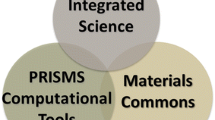Abstract
We are excited to report that the first articles in the new MRS Bulletin Impact section are published in this November 2020 issue of MRS Bulletin. As the flagship publication of the Materials Research Society (MRS), MRS Bulletin is committed to offering a powerful platform for cutting-edge materials research content. With the addition of the new Impact section that publishes original research,1MRS Bulletin has opened its next chapter and expanded its role as a scientific journal with a more diverse set of content. As a member-driven society, our mission is to provide the best possible service for the community and contribute to our members’ successes and impacts as researchers, educators, and leaders in academia, government, and industry.
Similar content being viewed by others
Avoid common mistakes on your manuscript.
We are excited to report that the first articles in the new MRS Bulletin Impact section are published in this November 2020 issue of MRS Bulletin. As the flagship publication of the Materials Research Society (MRS), MRS Bulletin is committed to offering a powerful platform for cutting-edge materials research content. With the addition of the new Impact section that publishes original research,1 MRS Bulletin has opened its next chapter and expanded its role as a scientific journal with a more diverse set of content. As a member-driven society, our mission is to provide the best possible service for the community and contribute to our members’ successes and impacts as researchers, educators, and leaders in academia, government, and industry.
In the first Impact article published in this issue, Citrin et al.2 report on an intriguing study that sheds light on the mechanisms of solid-state Li batteries, including the discovery of mechanical deformation mechanisms of deposited Li nanostructures. The authors explain how the stiffness and strength of nano-sized electrodeposited Li contributes to battery failure, within the framework of dislocation-governed nanoscale plasticity of crystals. The paper is accompanied by an Opinion & Perspective article by McDowell3 that puts these discoveries into context and helps make the research more accessible to a broader audience.
For the Impact section, we are especially excited about the opportunity to not only share original research but also to put the findings in the context of the field for some of the papers with accompanying Opinion & Perspective articles. This will help with accessibility of the work and draw interest and connections from distinct disciplinary areas. The multidisciplinary nature of materials research necessitates such crosstalk, and the facilitation of making connections is one of the goals of the new section.
There are several other Impact papers already published online, including an article by Ni and Gao4 on using deep learning applied toward elastic modulus identification. This paper reports a significant milestone that now allows researchers to overcome computationally costly methods that cannot meet the demand for real-time solutions for manufacturing and clinical applications. An article by Zhao et al.5 discusses vibration-based methods that can be used to effectively characterize the physical properties of biological materials, with an increasing focus on the mechanics of individual, living cells. Frankel6 makes a case for visual components of materials research to help clarify the researchers’ thinking and engage the public. Formal programs in teaching visual communications will help show the world how to look at and understand science.
With our new alliance with Springer Nature in 2021, we will soon be opening an electronic submission system for the MRS Bulletin Impact section, in which we will seek submissions of original research from the broad community. We will accept both shorter (letter-type) and longer (article-type) papers reporting outstanding and impactful research. Each paper includes an Impact Statement to explain the significance and transformative nature of the results reported to materials researchers in other fields. We need your support to make this new “impactful” section a success, and extend an invitation to submit your highest-impact materials research to us!
With the help of our Editorial Board and working with key groups at MRS such as the Topical Staging Task Forces, Meeting Chairs, and the MRS Publications Committee, the new section will contribute to identifying emerging hot topics and trends.
As we embark on this journey, please let us know your ideas and thoughts on how we can make MRS Bulletin a more valuable resource for the materials community. From all of us on the MRS Bulletin team, we hope to “see” you soon and hope that you, your colleagues, friends, and family are doing well during these challenging times.
References
G.R. Rao, M.J. Buehler, New Horizons for MRS Bulletin, MRS Bull. 45 (1), 6 (2020).
M.A. Citrin, H. Yang, S.K. Nieh, J. Berry, W. Gao, X. Pan, D.J. Srolovitz, J.R. Greer, From Ion to Atom to Dendrite: Formation and Nanomechanical Behavior of Electrodeposited Lithium, MRS Bull. 45 (11), 891 (2020), doi:10.1557/mrs.2020.148.
M.T. McDowell, Nanomechanical Measurements Shed Light on Solid-State Battery Degradation, MRS Bull. 45 (11), 889 (2020), doi:10.1557/mrs.2020.149.
B. Ni, H. Gao, A Deep Learning Approach to the Inverse Problem of Modulus Identification in Elasticity, MRS Bull. (2020), doi:10.1557/mrs.2020.231.
J. Zhao, W. Li, X. Guo, H. Wang, J.A. Rogers, Y. Huang, Theoretical Modeling of Tunable Vibrations of Three-Dimensional Serpentine Structures for Simultaneous Measurement of Adherent Cell Mass and Modulus, MRS Bull. (2020), doi: 10.1557/mrs.2020.253.
F.C. Frankel, Picturing Science and Engineering, MRS Bull. (2020), doi:10.1557/mrs.2020.203.
Rights and permissions
About this article
Cite this article
Buehler, M.J., Rao, G.R. Reaching the horizon: First MRS Bulletin Impact articles published. MRS Bulletin 45, 879 (2020). https://doi.org/10.1557/mrs.2020.305
Published:
Issue Date:
DOI: https://doi.org/10.1557/mrs.2020.305



